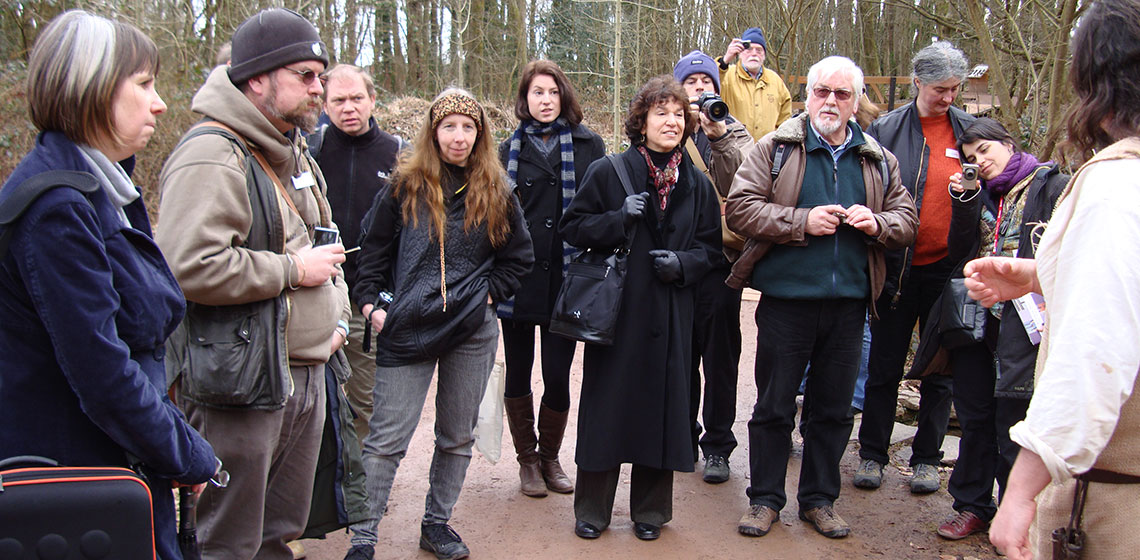
The EXARC General Meeting was held in Cardiff, Wales, UK from the 5-7 of March 2010. Participants visited St. Fagans, an open-air museum, on Saturday the 6th. This review focuses on the papers and the discussion that took place on Sunday the 7th, entitled Open Air and Experimental Archaeology in the UK: recent work and ongoing projects. This day was set aside to present current work going on in open-air museums and related institutions, as well as to discuss the relationship between open air museums and experimental archaeology centres and Universities.
In the first paper, The embedded value of old experiments: roundhouse and experimental earthwork excavations, Prof. Martin Bell (UK) presented a brief history of large scale experimentation and open-air museums over the past century, as well as work currently taking place at Reading University. He focused primarily on the 'embedded value' of these older experiments, and how people today can find scientific value through studying older experimental sites - particularly when it comes to studying taphonomic issues, artefact distribution and spacial use of buildings. He also suggested ways in which open-air centres can work towards addressing academic and scientific questions.
The following presentations discussed current work taking place in the United Kingdom. Nick Coles and Jane Stewart (UK) discussed the work taking place at Cosmeston Medieval Village (Cosmeston Medieval Village - Heritage by accident!). The site was originally meant to be a rescue excavation, but an increasing public interest and a large available work force, supplied by Manpower Services Commission, led to the production of several reconstructions being built on the site. Eventually the excavation turned into a large-scale representation of a Medieval village that is open to the public. Kim Siddorn (UK) of the living history group Regia Anglorum presented a different side to reconstruction (Wychurst: building the past into the future). The group has built a facsimile of an Anglo-Saxon manor house, which they use on a regular basis. Both Phil Bennett, (UK) of the Castell Henllys Iron Age Fort, and David Freeman (UK) presented on a topic close the heart of UK open-air museums: Round Houses. Bennett discussed the different sorts of round houses excavated at Castell Henllys, and the issues involved in their reconstruction. Freeman presented his attempts thus far at constructing a light weight round house that would have been suitable for man-made islands.
The last portion of the afternoon was spent on a discussion of the relationship between universities and open-air museums, moderated by Prof Bruce Bradley of the University of Exeter (Universities and Open Air Museum: of mutual benefit?). Bradley expressed his wish for people to move away from the semantics regarding the definition of 'experimental archaeology,' and instead move towards strengthening the relationships between academics and open-air centres. Bradley echoed Bell’s statement that research questions can often affect collaboration, and that sometimes academics may have different questions than centres, which are geared more towards the public interest.
However, centres such as St. Fagan’s offer an opportunity to foster long-term research that can be shaped by both academics and open-air centres. Bradley stated that the way to foster such relationships is to develop a method of looking at different questions, but first what is needed is hypothesis to test. If centres can begin to supply new questions for academics, then academics can attempt to answer these questions through experimentation.
At this point the floor was opened to discussion, and one of the participants reminded the group of the practical issues related to running open-air museums. Dealing with the needs of visitors, as well as the day to day running of large centres, can overshadow the development of academic practice. Once the balance shifts heavily to dealing primarily with the public, it is hard to regain a balance.
A participant mentioned that one solution might be to separate experimentation from the educational programs that many open-air centres run. This is worth consideration, as educational activities often lend themselves towards the presentation of craft-skills, such as weaving or pottery making, as opposed to testing hypotheses concerning a process or technology. The same participant also suggested that centres with building constructs can incorporate scientific study by addressing one or two questions per building.
The discussion then moved on to practical discussions regarding making such partnerships viable. This included funding and increasing the impact of experiments. Partnerships between centres and academic institutions can be mutually beneficial when it comes to getting funding for experiments and research. The wider effect of research is considered important by many of the funding bodies in the UK - and making experiments available to the public by way of open-air centres is one way to increase impact. As always, more chances for funding are beneficial to both academics and open-air museums.
The discussion concluded with the statement that the goal has to be to develop experiments that are beneficial for centres, academics and for the public. This requires active participation on both sides of the aisle to develop research questions and follow them through with experiments. Many of the participants referred to the work being done at Lejre as an example of good practice. The over all consensus of this meeting between people from open-air museums and academic institutions was that something concrete should come out of this conference, and that hopefully relationships will be formed between the museums and academics.